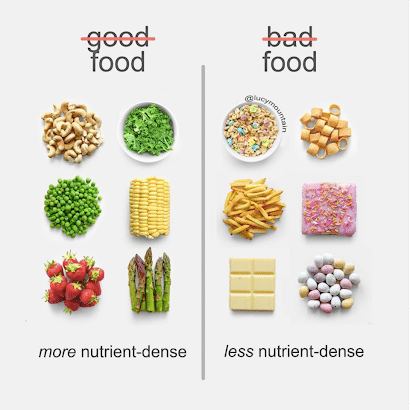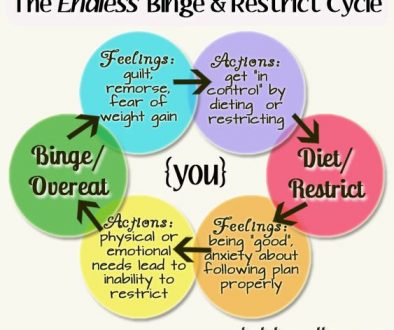The All Foods Fit Model to Prevent Disordered Eating
Prevent Disordered Eating
The All Foods Fit Model is the idea that all foods can fit into a person’s daily meal planning and preparation. The model does not support the idea of categorizing foods into black or white categories–such as labeling foods as “good” vs. “bad” or “healthy” vs. “unhealthy.” The model does not support engaging in fad or elimination diets such as Keto, Atkins, SouthBeach, Juice Cleanses, or Clean Eating.
When it comes to using this model, there are certain benefits that will facilitate a person’s connection with food different from labeling foods that we often see in food/diet marketing material. When a person begins to categorize foods, it begins attaching emotions and ideas about the specific food item. For example, viewing ice cream as a “bad” or “unhealthy” food can lead someone to feelings of guilt after eating. Foods can begin to hold power over a person and their choices leading to a life full of increased cravings and preoccupation with foods that are seen as “off limits.” This way of thinking can encourage a disconnection of trust between one’s mind and one’s body. People will have difficulty knowing when they are hungry compared to when they are full.

Taking the approach of integrating all foods into someone’s meal planning, it reduces the likelihood of labeling items and attaching emotions to the food. With this benefit, a person will begin to trust their own choices and interests and notice the approach of “food as food.” This can reduce overall cravings and thoughts around food in general with a lifetime change of trusting one’s self when it comes to eating and their body.
In order to begin this change, a person has to become aware of their own personal food judgments and begin to work more towards food neutrality and flexible thinking.
What are Food Judgments?
- Food judgments are beliefs that we have surrounding food; labeling food as “good” or “bad” and rules around food.
- When a food judgment is created there is an emotional aspect resulting in an increase of guilt and/or shame when allowing oneself to have a perceived “bad” food item.
Examples of Food Judgments:
- No eating after a certain time.
- That was a “big” meal–now I have to go to the gym.
- I have a family gathering where I will be having a “bigger” meal; therefore, I will limit my food prior to the gathering.
- I have to limit or can’t have this food item; it has too many carbs and/or fats.
- This food is unhealthy.
How to Model Food Neutrality
Step 1: Identifying Your Own Food Judgments
- The goal of “All Foods Fit Model” is to bring awareness to one’s own food judgments and begin to practice neutrality on the way we perceive food.
- Take a moment to reflect (non-judgmentally) on any food judgments or rules that are currently present for you.
- One way to begin identifying and neutralizing food judgments is by starting an intuitive eating journal focusing on the emotional response that occurs after the meal and observing hunger cues/fullness instead of emphasizing on the calorie content.
Step 2: Reframing Your Thinking Around Food
- After identifying your own food judgments, it is important to challenge and reframe these thoughts.
- Removing absolutes, black or white thinking (i.e. “I must always” and “I shouldn’t/should only”)
- Changing the script to practice self-compassion and allowing permission; using words such as, “may,” “can,” and “okay.”
- Examples:
- I am learning to trust myself with my hunger cues and food
- I can have this food item in moderation
- This is a process, I’m taking it one day at a time
- It’s okay for me to want ice cream in the afternoon
Step 3: Integrating Flexible Thinking Into Action
- There will be ups and downs in this process; there is no such thing as failure when integrating different ways of thinking around food, only learning.
- The more practice with flexible thinking the easier it becomes both mentally and physically.
- Taking a moment to acknowledge the wins for the week big or small.
- In the long run, this will assist in creating a better, neutralized relationship with food.
How can this approach prevent disordered eating in children?
- This approach prevents disordered eating in children because it decreases the emotional attachment to food (guilt and shame), brings awareness (body, thoughts, emotions), and decreases negative self-talk (“I am bad”) that can result in other mental health concerns.
- In a large study of 14-15 yr olds, dieting was the most important predictor of developing an eating disorder.
Those who dieted moderately were 5x more likely to develop an eating disorder and those who practiced extreme restriction were 18x more likely to develop an eating disorder than those who did not diet.
Articles:
- Making Sure “All Foods Fit Model” includes all food
- How to stop judging your food choices once and for all
- Let Food Judgment Become Food Curiosity
- Reframing the Way we Build Our Child’s Relationship with Food
Podcast:
Mom Genes The Podcast: https://www.momgenesthepodcast.com/
By:
Tabitha Guillaume, LCPC
Karina Lima, LCSW



